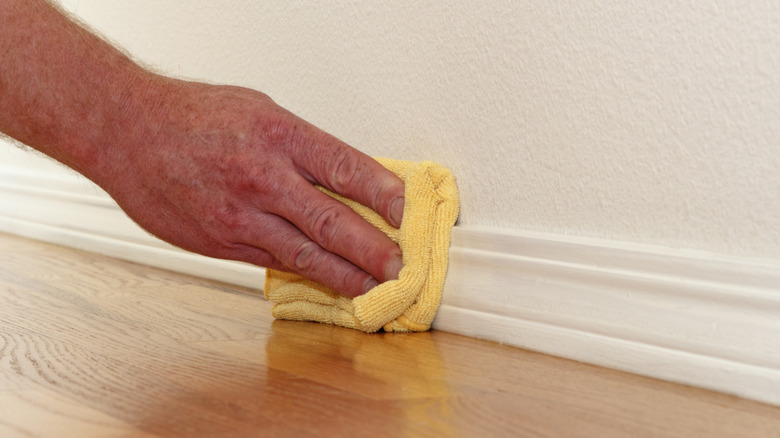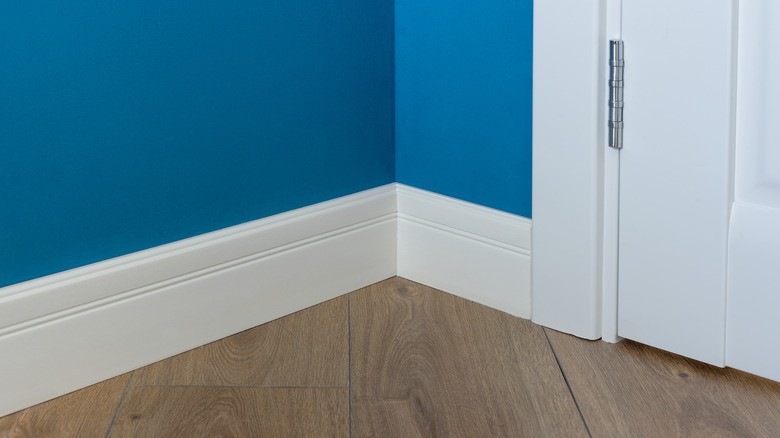Why You Should Be Putting Your Paint Swatches Next To Your Trim
Paint is a quick and easy way to completely transform a room. You can select a moody, saturated hue to give a space a cozy ambiance, or go toward the other end of the spectrum, freshening up a formerly dark area with a light, airy shade.
Now, you may already know the importance of leaving your paint swatches up to see how they look at various points throughout the day. This is because the same color can look radically different according to the lighting that's hitting it, and you'll want to ensure you're as happy with the hue in the bright morning or afternoon light as you are in the more muted evening lighting. If your space has windows or other light sources, you might have even tried out swatches on different walls in the room to truly get a sense of the color in all scenarios.
However, if you are always testing out swatches in the middle of the wall, you need to get a second swatch to place somewhere you have trim, whether that's your baseboards, your ceiling, or framing around your windows and doors.
The reason is simple — the two shades will be right next to one another when you actually paint the space, so you need to make sure they will work together. Particularly if you're pairing a pale, near-white hue with white trim, you run the risk of your trim looking a little dingy after a fresh coat of paint is on the walls.
How to quickly refresh your trim
While you might spot clean areas on your trim that have gotten dirty, we're willing to bet it's been a while since you've thoroughly cleaned every square inch of your home's trim. It's a time-consuming task that requires a fair bit of effort, since you're either hunched over near the ground or balanced atop a chair or ladder trying to reach the higher areas.
If your new paint color has rendered your trim's appearance less than ideal, the first step to take is to really give the trim a proper cleaning. A simple mixture of warm water and dish soap works wonders on most trims, including both painted and wood variations. If you're trying to revive white painted trim and truly make it sparkle, you might consider using a Magic Eraser to really scrub away any grimy spots. For wood trim, a cleaner specifically formulated for wood can help add a bit of sheen.
While simple trim is easy enough to clean, if your home has particularly intricate molding or trim, you'll likely need to spend even longer scrubbing out all those little nooks and crannies. Yes, it takes time, but it's still simpler to clean than to repaint every square inch of trim in a room.
Another option — splash on a fresh coat of paint
If you've tried cleaning your trim and still feel it looks dull and dingy in comparison to your freshly painted walls — or, if your new wall color has inspired you to mix things up with another color of trim — the other option is to splash a fresh coat of paint on the trim as well. Just don't be afraid to stray from the standard shades of white.
People often tend to think of white as the default trim color. After all, it matches a wide range of shades and is a neutral option. However, if you're repainting all your trim and not just doing touch-ups, it's time to think outside the box and consider all the possibilities.
For example, if you're dealing with a relatively small space, a sharp contrast between the wall color and trim could actually draw attention to the size limitations of the room. By painting the trim and walls the same shade (and even carrying that hue to the ceiling, if you're feeling bold), it gives the illusion that the space is a bit larger since the trim isn't visually halting your gaze. Even with the same hue, you may want to use a different finish, though, opting for a semi-gloss so your trim is easy to wipe down.
Alternatively, you might consider pairing a relatively neutral wall with a more saturated trim shade for an unexpected burst of color.


